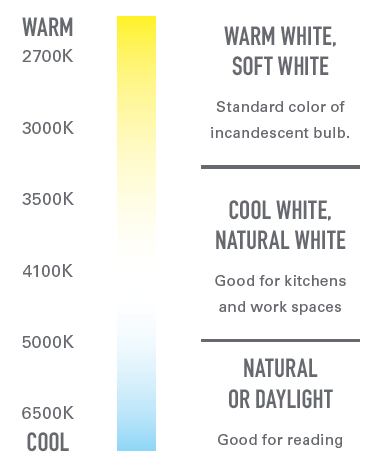It’s pretty clear we’re huge fans of LED light bulbs. But you may be thinking: “Why?”
We’re glad you asked. If you’ve ever wondered what the difference between bulbs is, this is your “light bulb moment!”
Before we get started, some good light bulb terms to know are lumens and watts. Watt-ch this video for a quick overview:
What are the different kinds of light bulbs?
Here’s a breakdown of the lights you can buy for your home — Incandescent, CFL, and LED:
Incandescent
Incandescent bulbs use a filament that’s heated to the point of glowing. Congress passed the Energy Independence and Security Act in 2007, requiring new energy-efficient lighting standards for basic light bulbs.
Standard incandescent bulbs are being phased out, and for good reason: They only last for one year on average and use up to 75% more energy than LED bulbs!
CFL
Compact fluorescent light, or CFL, light bulbs are filled with mercury vapor that emits UV light when electricity is applied to it. The bulbs have a coating inside that turns UV rays into visible light.
Although CFL bulbs use less energy than incandescent light bulbs, there’s only one clear winner when it comes to saving energy: LED!
LED
Light-emitting diodes, or LED, are semiconductors that turn into light as electricity passes through them. LEDs are more efficient than incandescent and CFL light bulbs, so less energy radiates from the bulbs as heat, making LEDs much cooler too.
LED lights also don’t burn out; they just grow dimmer. Most LED lights have an average life span of 25,000 hours, so if you kept your LED bulb on 24/7/365, it could last nearly three years! Oh yes, they also use way less watts. In fact, LEDs are at least 75% more energy efficient than incandescent.
Watts the big deal about LED?
Here’s how many watts each bulb uses for the same light output.
| LED | CFL | Incandescent |
| 14 – 16 watts | 23 watts | 100 watts |
| 12 – 13 watts | 20 watts | 75 watts |
| 8 – 9 watts | 15 watts | 60 watts |
What about color?
The light bulb you choose isn’t just about the energy it saves or how long it lasts. Lighting directly affects the atmosphere and mood of a home.

Light color is measured on the Kelvin (K) temperature scale. A lower Kelvin number means a more yellowish light, while a higher Kelvin number means the light is white to blue.
Worried about cost?
Don’t be. LEDs do cost a little bit more, but they last much longer and use far less energy. Also, we’ll help you pay for them, with instant savings of up to $2 per bulb at participating retailers!
